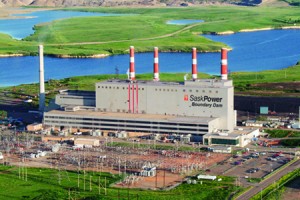
Dear EarthTalk: There’s a lot of talk about the potential for renewable energy sources like solar and wind. But cheap, abundant coal is still going to power the world for a long time. How can we harness the energy from coal without emitting our way into a much warmer future? — Sally Ristau, Erie, PA
Today coal still accounts for some 40 percent of worldwide electricity generation. The International Energy Agency (IEA) predicts that global demand will continue rising to record levels, topping nine billion metric tons annually by 2019. And despite efforts by China to moderate coal consumption, China still accounts for three-fifths of this short-term “demand growth.” Meanwhile, India and other countries in Asia are also ramping up their coal use, offsetting declines in Europe and the U.S.
“The world is not going to stop using coal … so we have to change how the world does use it,” says Eric Redman, an outspoken advocate for realistic clean energy solutions and co-chair of the Seattle-based Summit Power Group. He says that the key is in teaching the world how to utilize carbon capture and sequestration (CCS) technologies, which take carbon dioxide (CO2) emissions out of smokestacks and reuses them or stores them in forms so they won’t enter the atmosphere and exacerbate climate change.
In October 2014, Canadian utility SaskPower launched the world’s first full-scale “clean coal” plant in Saskatchewan. Named one of National Geographic’s “10 Energy Breakthroughs of 2014 that Could Change Your Life” and winner of the 2015 “POWER Plant of the Year” award, the Boundary Dam Power Station Unit 3 CCS project has now exceeded expectations, capturing 135,000 metric tons of CO2 in less than a year. The plant is on target to absorb as much as a million metric tons of CO2 annually.
And in June 2015, SaskPower opened its Capture Test Facility, a lab that lets researchers test equipment, chemical innovation and engineering designs in a highly controlled environment. Other companies are also using the facility to develop and test CCS technologies for potential use in their own power plants.
Other promising CCS technologies in the works include coal gasification, whereby energy from coal is converted into a gas that can be burned as CO2 is removed, and the Polaris Membrane System, which uses a specially-designed membrane to capture 90 percent of the CO2 emitted from a coal-burning power plant.
These technologies are indeed promising, but cost still remains the main obstacle to making CCS mainstream. “It is obviously cheaper to dump something in the atmosphere (for free) than to pay the capital and operating costs of capturing and sequestering it,” says Summit Power’s Redman. “There are very few mechanisms currently available to help pay those costs,” he says, adding: “Globally we’ve so far spent on carbon capture and sequestration less than one percent of what we’ve already spent on renewable energy, so naturally we are not yet very far down the CCS cost curve.”
And while many environmentalists shudder to think that we will continue to burn coal at all, we may not have a choice. “I think most climate experts would agree that the maximum realistic deployment of renewables, efficiency and nuclear power will not, by themselves, allow us to limit atmospheric concentrations of CO2 to 450 parts per million by mid-century,” says Redman, adding that CCS is both necessary and ultimately inevitable. “But we need to move more rapidly.”








